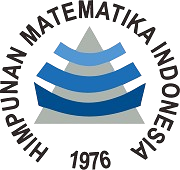Model Matematika Penyakit Kolera Melalui Kontak Antar Individu, Sumber Air, dan Lalat
DOI:
https://doi.org/10.30736/voj.v4i2.539Keywords:
Analisis Sensitifitas, Kestabilan Titik Ekuilibrium, Kolera, SIWRAbstract
Penelitian ini mengembangkan model matematika penyebaran penyakit kolera menggunakan model SIWR yang ditambahkan dengan vektor lalat. Berdasarkan model matematika tersebut, dicari titik kestimbangan bebas penyakit, titik kestimbangan endemik, dan bilangan reproduksi dasar (R0). Hasil analisis kestabilan titik kestimbangan bebas penyakit diperoleh bersifat stabil asimtotik lokal saat R0<1. Simulasi model dilakukan dengan nilai-nilai parameter yang diambil dari beberapa jurnal dan mengambil kasus di Haiti. Hasilnya penyakit kolera di Haiti dalam waktu mendatang akan menghilang.Selanjutnya dilakukan analisis sensitivitas parameter-parameter model terhadap R0, hasilnya terdapat dua parameter yang dominan berpengaruh terhadap penyebaran penyakit kolera yakni laju kontak infektif individu rentan dengan individu terinfeksi dan tingkat kesembuhan individu dari penyakit kolera.Downloads
References
Anggaraditya, B. A. (2015). Menekan Laju Penyebaran Kolera di Asia dengan 3SW (Sterilization, Sewage, Sources, and Water Purification). Intisari Sains Medis, 3(1), 83–87. https://doi.org/10.15562/ism.v3i1.71
Basumatary, C., Kaur, R., & Kaur, S. (2021). Treatment Strategies Of Cholera: A Review. European Journal of Translational and Clinical Medicine, 7, 2020. https://www.researchgate.net/publication/348555388_Treatment_Strategies_Of_Cholera_A_Review
Blow, N. S., Salomon, R. N., Garrity, K., Reveillaud, I., Kopin, A., Jackson, F. R., & Watnick, P. I. (2005). Vibrio cholerae infection of Drosophila melanogaster mimics the human disease cholera. PLoS Pathogens, 1(1), 0092–0098. https://doi.org/10.1371/journal.ppat.0010008
Brooks, G. F. , K. C. C. J. S. B. S. A. M. dan T. A. M. (2010). Medical Microbiology, Twenty-Sixth edition. McGraw-Hill Companies.
Capasso, V., & Paveri-Fontana, S. L. (1979). A mathematical model for the 1973 cholera epidemic in the European Mediterranean region. Revue d’épidémiologie et de Santé Publiqué, 27(2), 121–132. https://pubmed.ncbi.nlm.nih.gov/538301/
Chitnis, N., Hyman, J. M., & Cushing, J. M. (2008). Determining important parameters in the spread of malaria through the sensitivity analysis of a mathematical model. Bulletin of Mathematical Biology, 70(5), 1272–1296. https://doi.org/10.1007/s11538-008-9299-0
Codeço, C. T. (2001). Endemic and epidemic dynamics of cholera: the role of the aquatic reservoir. BMC Infectious Diseases, 1(1), 1–14. https://doi.org/10.1186/1471-2334-1-1
Diekmann, O., Heesterbeek, J. A. P., & Roberts, M. G. (2009). The construction of next-generation matrices for compartmental epidemic models. Journal of the Royal Society, Interface / the Royal Society, 7, 873–885. https://doi.org/10.1098/rsif.2009.0386
Dolstad, H. A., Franke, M. F., Vissieres, K., Jerome, J.-G., Ternier, R., & Ivers, L. C. (2021). Factors associated with diarrheal disease among children aged 1–5 years in a cholera epidemic in rural Haiti. PLOS Neglected Tropical Diseases, 15(10), e0009726-. https://doi.org/10.1371/journal.pntd.0009726
Filary-Szczepanik, M. (2020). The discipline in the times of Cholera. In Global Affairs (Vol. 6, Issue 3, pp. 243–246). Taylor & Francis. https://doi.org/10.1080/23340460.2020.1842226
Ghosh, M., Chandra, P., Sinha, P., & Shukla, J. B. (2004). Modelling the spread of carrier-dependent infectious diseases with environmental effect. Applied Mathematics and Computation, 152(2), 385–402. https://doi.org/10.1016/S0096-3003(03)00564-2
Global Health Observatory (GHO) Data. (2015). Cholera Cases Reported. Http://Www.Who.Int/Gho/Epidemic.Diseases/Cholera/Epidemics_text/En/.
Khamesipour, F., Lankarani, K. B., Honarvar, B., & Kwenti, T. E. (2018). A systematic review of human pathogens carried by the housefly (Musca domestica L.). BMC Public Health, 18(1). https://doi.org/10.1186/s12889-018-5934-3
Lawley, R., Curtis, L., & Davis, J. (2012). The food safety hazard guidebook. Royal Society of Chemistry.
Liao, S., & Wang, J. (2011). Stability analysis and application of a mathematical cholera model. Mathematical Biosciences and Engineering, 8(3). https://doi.org/10.3934/mbe.2011.8.733
Luquero, F., Rondy, M., Boncy, J., Munger, A., Mekaoui, H., Rymshaw, E., Page, A.-L., Toure, B., Degail, M. A., Nicolas, S., Grandesso, F., Ginsbourger, M., Polonsky, J., Alberti, K., Terzian, M., Olson, D., Porten, K., & Ciglenecki, I. (2016). Mortality Rates during Cholera Epidemic, Haiti, 2010–2011. Emerging Infectious Disease Journal, 22(3), 410. https://doi.org/10.3201/eid2203.141970
Manaqib, M., Fauziah, I., & Mujiyanti, M. (2019). Mathematical Model for MERS-COV Disease Transmission with Medical Mask Usage and Vaccination. InPrime: Indonesian Journal of Pure and Applied Mathematics, 1(2), 30–42. https://doi.org/10.15408/inprime.v1i2.13553
Mandal, S., Mandal, M. D., & Pal, N. K. (2011). Cholera: a great global concern. Asian Pacific Journal of Tropical Medicine, 4(7), 573–580. https://doi.org/10.1016/s1995-7645(11)60149-1
Marquez, J. G., & Krafsur, E. S. (2002). Gene flow among geographically diverse housefly populations (Musca domestica L.): a worldwide survey of mitochondrial diversity. Journal of Heredity, 93(4), 254–259. https://doi.org/10.1093/jhered/93.4.254
Mukandavire, Z., Liao, S., Wang, J., Gaff, H., Smith, D. L., & Morris, J. G. (2011). Estimating the reproductive numbers for the 2008-2009 cholera outbreaks in Zimbabwe. Proceedings of the National Academy of Sciences of the United States of America, 108(21), 8767–8772. https://doi.org/10.1073/pnas.1019712108
Najar, A. M., Sudarsana, I. W., Albab, M. U., & Andhika, S. (2022). Machine Learning untuk Identifikasi Jenis Kanker Darah (Leukemia). Vygotsky: Jurnal Pendidikan Matematika Dan Matematika, 4(1), 47–56. https://doi.org/10.30736/voj.v4i1.493
Perko, L. (2000). Differential Equations and Dynamical Systems. Springer.
Posny, D., Wang, J., Mukandavire, Z., & Modnak, C. (2015). Analyzing transmission dynamics of cholera with public health interventions. Mathematical Biosciences, 264, 38–53. https://doi.org/10.1016/j.mbs.2015.03.006
Pourabbas, E., d’Onofrio, A., & Rafanelli, M. (2001). A method to estimate the incidence of communicable diseases under seasonal fluctuations with application to cholera. Applied Mathematics and Computation, 118(2–3), 161–174. https://doi.org/10.1016/S0096-3003(99)00212-X
Resmawan, R., & Yahya, L. (2020). Sensitifity Analysis of Mathematical Model of Coronavirus Disease (COVID-19) Transmission. Cauchy, 6(2), 91. https://doi.org/10.18860/ca.v6i2.9165
Robertson, S. L., Eisenberg, M. C., & Tien, J. H. (2013). Heterogeneity in multiple transmission pathways: Modelling the spread of cholera and other waterborne disease in networks with a common water source. Journal of Biological Dynamics, 7(1), 254–275. https://doi.org/10.1080/17513758.2013.853844
Silva, A. J., & Benitez, J. A. (2016). Vibrio cholerae Biofilms and Cholera Pathogenesis. PLOS Neglected Tropical Diseases, 10(2), e0004330-. https://doi.org/10.1371/journal.pntd.0004330
Tien, J. H., & Earn, D. J. D. (2010). Multiple transmission pathways and disease dynamics in a waterborne pathogen model. Bulletin of Mathematical Biology, 72(6), 1506–1533. https://doi.org/10.1007/s11538-010-9507-6
Van Den Driessche, P., & Watmough, J. (2002). Reproduction numbers and sub-threshold endemic equilibria for compartmental models of disease transmission. Mathematical Biosciences, 180(1–2), 29–48. https://doi.org/10.1016/S0025-5564(02)00108-6
Wiggins, S. (2003). Introduction to Applied Nonlinear Dynamical Systems and Chaos (second). Springer.
World Health Rangkings. (2015). Health Profile: Haiti. Http://Www.Worldlifeexpectancy.Com/Country-Health-Profile/Haiti .
Yahya, L., Nurwan, N., & Resmawan, R. (2022). Menentukan Waktu Optimal untuk Pembuatan Kerajinan Sulaman Karawo Menggunakan Aljabar Max-Plus. Vygotsky: Jurnal Pendidikan Matematika Dan Matematika, 4(1), 23–34. https://doi.org/10.30736/voj.v4i1.442
Downloads
Published
How to Cite
Issue
Section
License
Copyright:
Authors who publish their manuscripts in this Journal agree to the following conditions:
- Copyright of any article on Vygotsky: Jurnal Pendidikan Matematika dan Matematika is held solely by the author under the Creative Commons Attribution 4.0 International license (CC BY NC SA).
- Authors can submit papers separately, arrange non-exclusive distribution of manuscripts that have been published in this journal into other versions (e.g. sending to the author's institutional repository, publication in a book, etc.) by acknowledging that the manuscript has been published for the first time in Vygotsky: Jurnal Pendidikan Matematika dan Matematika.
License:
Vygotsky: Jurnal Pendidikan Matematika dan Matematika is published under the terms of the Creative Commons Attribution 4.0 International License (CC BY NC SA). This license permits anyone to copy and redistribute this material in any form or format, compile, modify and develop this material for any purpose as long as it is not for commercial purposes. Additionally, anyone must provide credit and distribute contributions under the license of the creator of the original work.











